That's No Rebel Moon...Or Is It?
Andor Season 2 Review
A planet covered in vast fields of grain has attracted the attention of the fascist regime that runs the galaxy. When they arrive, one of them sexually assaults a local. He's stopped in the act, though, when he is violently dispatched by a female warrior fugitive who has been hiding out on the planet, and who now must flee and find help.
Is this a scene from:
(a) Zack Snyder's Rebel Moon
or
(b) Star Wars?
Given the title of this article, you've probably guessed that, as of Andor season 2, the answer is, in fact, both. Along with such quotable, classic Star Wars lines as “May the Force be with you” and “This is the way,” we can now add, “He tried to rape me!” and 'Tear the shit out of this place!”
That's right, kids, it's time once again for Andor, the edgelord Star Wars series that it's safe to like even if you hate everything else Lucasfilm puts out, and have made the weekly clickbait videos to prove it. With the whitest cast and most humorless tone – nearly everyone on the show appears to hail from the planet UK-1975, and even Diego Luna is half-British – Rogue One prequel Andor isn't really for kids, less because of sex and violence, and more because it's lots of slow scenes of people standing around talking, or listening to wiretaps. (They'll love the initial TIE fighter chase scene that feels like the Star Tours ride, and probably very little thereafter.) It's never less than apparent that those behind the show think themselves very smart and serious, though they may have missed the point that a franchise based on George Lucas' childhood memories of Flash Gordon serials was never particularly meant to be either.
When there's a sexual assault threat in a Zack Snyder movie, it blends in with the overall aesthetic of a kid loudly yelling every profanity he can for three hours, and becomes part of the absurdity. In Star Wars, it feels like misreading the vibe. I'm not offended by the content – my strong opinions of what the Skywalker saga ought to be aside, Star Wars is becoming a much larger umbrella to try different tones. But Andor arguably forgets that it's filling in one of the unseen gaps in a saga for children (and children at heart). It's like, as an adult watching, I figure Han and Leia probably had sex that first night in Cloud City. It doesn't mean I need to see Bertolucci's Last Tango in Bespin get the greenlight as part of canonical lore.
Were you hoping that the show would finally add some much-needed levity with the addition of K-2SO (Alan Tudyk), the scene-stealing robot from Rogue One who was depicted as the longtime partner of Cassian Andor (Diego Luna)? Well, oopsie, it turns out K-2SO is an expensive special effect, and therefore Cassian really didn't know him as long as you might have thought. He's in maybe three episodes, tops, and only in one of them does he really have a role like a full-fledged partner. His presence absolutely improves things, no doubt – just as season 1 improved mightily on the back end by becoming a prison flick, so too does season 2 improve when it finally becomes Star WARS rather than Star Life Under Fascism. If you're not up for 12 episodes of this, it might be worth tuning in around episode 9, when Mon Mothma (Genevieve O'Reilly) gives her final FU speech to the Senate and truly becomes the Rebel leader we've seen from Return of the Jedi onward.
Side note: It's hilarious when people address her by name, saying things like, “How are you, Mon?” if you imagine the characters to be doing the whitest reggae voices you've ever heard. Empire Informer, you no say Cassian Andor he have no blame...a licky pew-pew down!
In general, the returning Rogue One actors are the highlights, though aside from O'Reilly, they're practically cameos. Ben Mendelsohn's Krennic is used for maximum impact, quite appropriately – as an actor, he's clearly in as much of a league above most of his costars here as Krennic is in Imperial rank. Forest Whitaker's main scene as Saw Gerrera could be eliminated from the narrative and make no difference, but what a shame that would be, as his nervous energy infuses one of the few characters not trying to blend in and keep their head down. His moment also adds a subtle tie to the sequel trilogy that only the fans will get – the same fans who understand what the upfront title “One Year Later: 4 BBY” means, and will have to explain to any casuals watching with them.
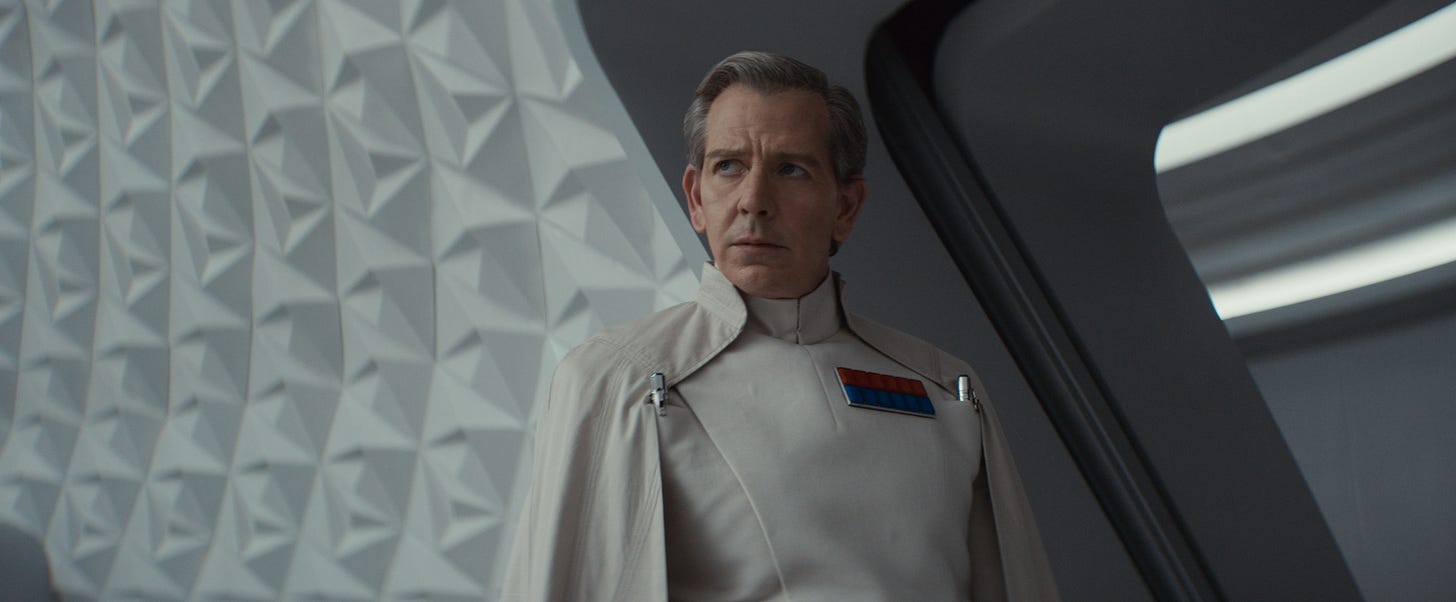
[Press like myself were forced to sign an NDA that required us, among other things, to attest that we were viewing the screeners not just alone, but in an area of the house where nobody else would be able to see the screen, and that we further promised not to even discuss the show with them or say anything about it afterwards. I hope my cat Toby was exempt. For what it's worth, there are no major surprises here for anyone who knows their Star Wars timelines, and it's unlikely anyone else will have the patience for all 12 episodes.]
One secondary role has been recast, presumably due to a scheduling conflict, but thankfully, mercifully, given the Peter Cushing precedent that Rogue One itself set, the show simply lets the recast stand, without digitally pasting on somebody else's face. More of that, please, Lucasfilm.
Andor season 2 is following an unusual release pattern – 12 episodes to be unleashed in sets of three, with each set of three representing a subsequent year in the life of the characters. One might ask why bother with episode boundaries, rather than simply releasing four movies? Once you see it, if you do after reading this review, you'll know. They more closely follow the structure of TV episodes than movies that have beginnings middles, and ends – in at least one case, it feels like they had to scramble to come up with a finish because the year had to have closure. And it's pretty weird when the show either does that, or omits key information, given how many excess slow scenes there are with either nothing happening, or subplots surrounding people we have no reason to care about. The heist in season 1 was dull; the heist in season 2 is duller, because, without spoiling too much, its outcome is completely preordained and it involves nobody who matters. Maybe it was shoehorned in just so there'd be some pew-pews in the story arc. Awkward story structure hampers our identification somewhat – there's a really, really belated bit of backstory that makes one character more relatable almost way too late.
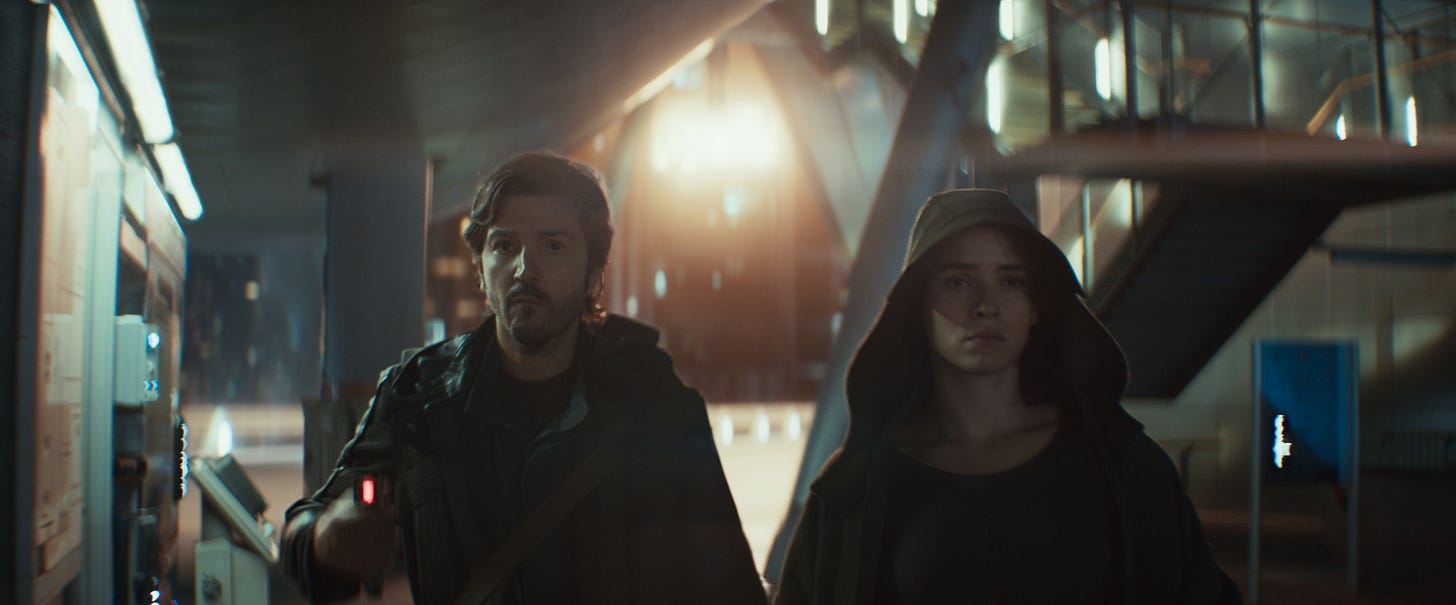
Cassian Andor himself, who isn't always the focus of the show despite the title, is never going to be caught drinking Dos Equis, if you get my drift. The most interesting man in Star Wars, he is not. It's mostly up to Adria Arjona as his lover Bix to make them seem like a compelling couple, and she deserves her own spinoff as a reward for this heroic effort. She's suffering PTSD from torture, and becoming a drug addict, because again, this is edgelord Star Wars. Still, she provides one way to identify with Cassian: like him, I find it hard to take my eyes off her.
Of the characters created for the show, my favorite continues to be Syril Karn (Kyle Soller), who's like Boimler from Star Trek: Lower Decks if he had joined the Empire instead of the Federation. His romantic relationship with hardass Dedra Meero (Denise Gough) adds new layers to his insecurities, and a scene in which Dedra finally tells off his overbearing mother is one calculated to make spouses the world over stand up and cheer. Don't mess with the boyfriend of an Empire chick.
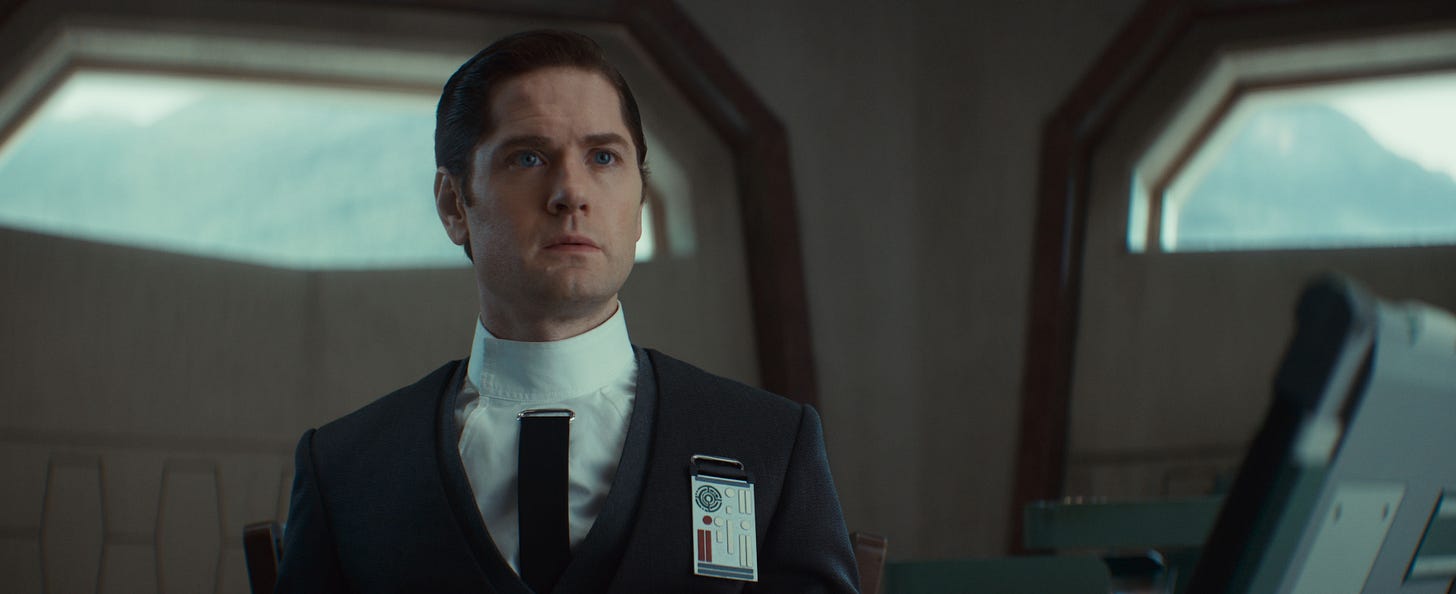
Incidentally, while there is no universal pronunciation of the fictional words herein – is the Rebel Base hidden on “Yavvin” or “Yaaaah-vin”? – at least one pronunciation of Dedra Meero sounds like “Dead Romero,” which is a wonderful in-joke reference if intentional. It's in the few moments of actual satire and humor that Andor soars the most, like when Imperial generals watch a travelogue film for a planet whose primary asset is spiders, or when Dedra does the whole changing outfits in front of a mirror cliché, but because she's an Imperial, everything is just basic black, gray, or white, and gender-neutral.
Showrunner Tony Gilroy likely didn't predict a second Trump administration, or he might have been able to simplify the narrative: as a I write this, said administration is planning to overrule state pollution restrictions by executive order, so that energy companies may be free to pollute. By contrast, to achieve the same thing in Andor, Emperor Palpatine plots to create a fake rebellion, give them time to grow, then prompt them to overreact, giving him a pretext to seize the planet. In his own authoritarian Empire, he can't just issue a command to Drill Baby Drill? We get to hear the Empire use “energy independence” as a buzzword, crack down on illegal immigrants even when it hurts their own industries to do so, and get the regular folks mad at perceived elites and snobs via “Imperial News.” If Star Wars can teach some people the warning signs of Fascism 101, good...but it's doing so via the grimdark show that tends to be most embraced by the MRA/”Fire Kathleen Kennedy” side of fandom, so good luck with that, I guess.
I'm not going to begrudge angsty men their own personal favorite Star Wars, but for the most part, it's not for me. A two-hour movie about stealing the Death Star plans already felt long, and forced-fan-servicey, minus the fun – ten hours is a lot to spend with some of the same people doing even less as they try to figure out what the Death Star plans even are. (Recall if you will that Count Dooku had the plans during Attack of the Clones, and construction begins at the end of Revenge of the Sith. In a universe not heavy on cloaking devices, you'd think somebody might have noticed by now.) Andor season 2 could probably have been a two hour movie if all the extraneous details were trimmed, but if Andor season 1 and its rapturous response from many corners means anything, it's that I clearly have no idea what Andor fans want.
For the rest of us, the last four episodes or so have the most bang for the buck.
Andor Season 2's first three episodes debut on Disney+ April 22nd.



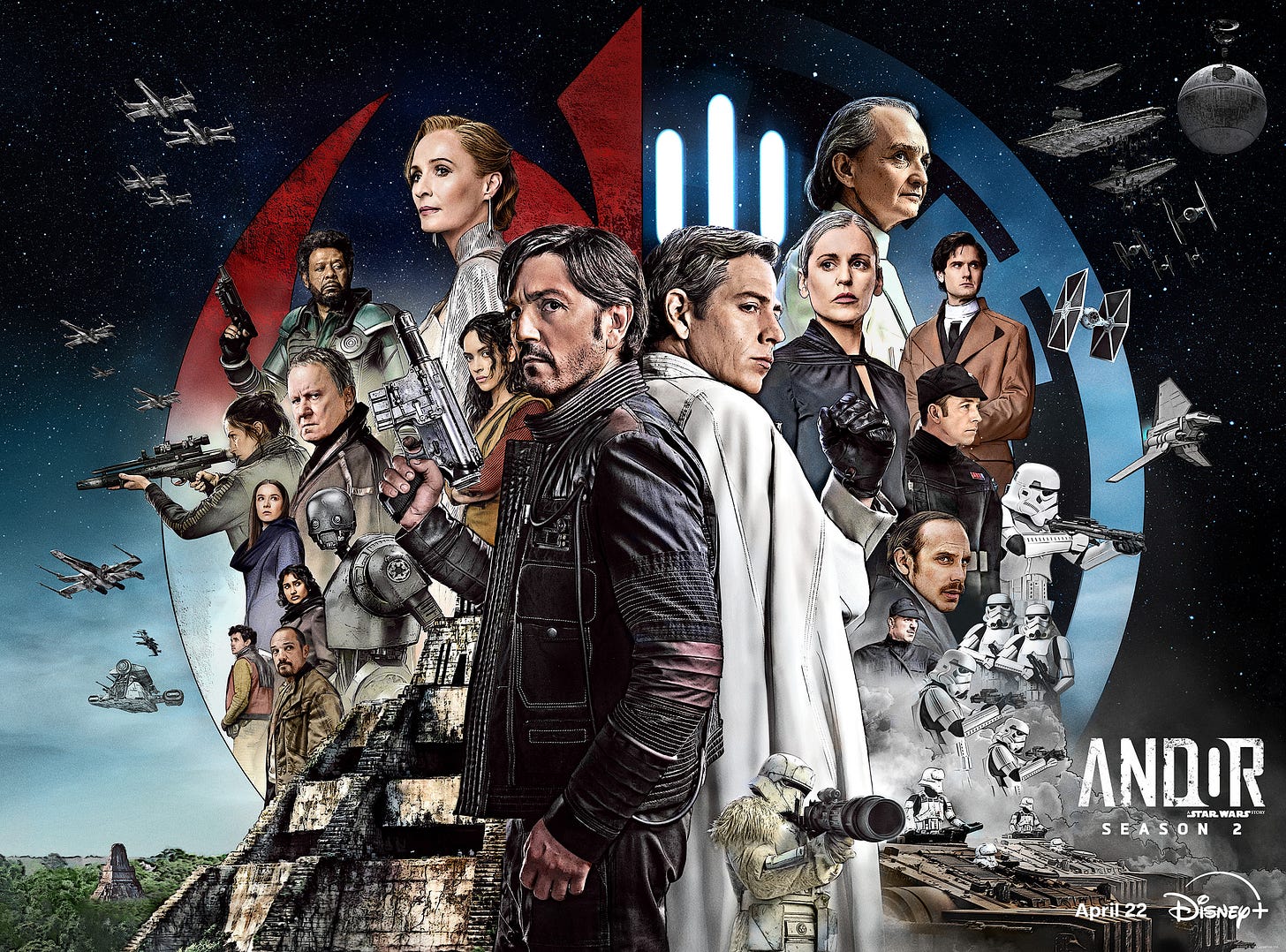
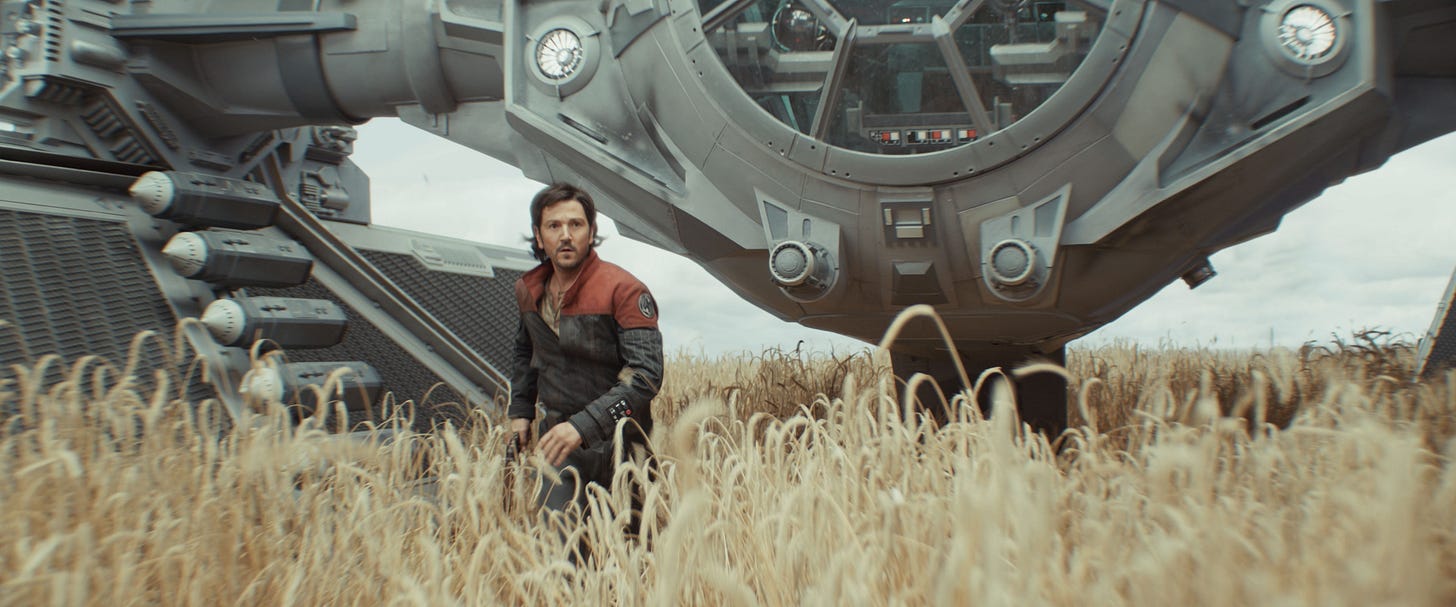

I think you are a bit hard on Star Wars fans. While I might disagree with them regarding Kathleen Kennedy's importance as a film maker historically (she's one of the most important producers in pop cinema history), I think her performance as studio head has been mixed and that her handling of SOLO is a good example of it. I like SOLO as a film, but needing to change directors midstream because things were getting off the rails isn't a good look for a studio head.
I think that critical Star Wars fans are typical of historical fandomsy. You can see this mentality in FREE ENTERPRISE (and in the continuing critiques of Robert Meyer Burnett who is far from and Edgelord) and in Simon Pegg's SPACED. I know that Pegg has apologized for that movie, but that's out of professional courtesy and guilt. The fact is that fandoms, all fandoms, have historically been very protective of the things they love. As I wrote about in my piece on The Eye of Argon, fandoms can also be quite cruel and while things may align along political lines today the cruelty of fandom has always been non-political.
I will also say that I think the "critical class" has been too dismissive of what they call "review bombing." My own personal experience with younger people, in this case college students, the opinions of many of my students match the negative reviews. I think the "review bombing" is sincere, even when I disagree with it. There are big disconnections in social groups right now and the expansion of the culture wars into pop culture, which used to be the target of rather than the vehicle for culture wars, is yet another annoying aspect of polarization.
Were I to update one of my favorite books on Polarization (Prius or Pickup?), I might call it KENNEDY OR SNYDERVERSE?
All of this reminds me that I really need to write my piece about toxic fandom. It discusses the time Forrest Ackerman (of Famous Monsters fame) attacked the writing of Clark Ashton Smith along the lines of the current Star Wars fans, only to be lambasted by H.P. Lovecraft and his Circle.